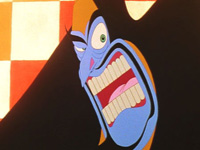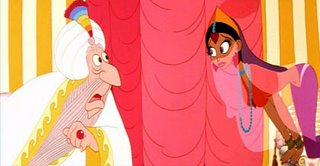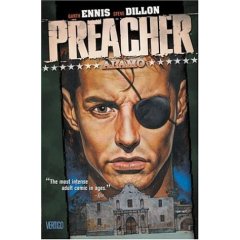THE THIEF AND THE COBBLER
One that has come to my attention recently, and which inspired this article, is Richard Williams’s The Thief and the Cobbler. ‘Never heard of it’, you say, and rightly so. Until its bastardised and incomplete release in 1995 after thirty YEARS of work, the film was only a much-admired legend in the animation industry, and given its disdainfully minor release in cinemas and on video, it has largely remained that way. What appears to be a trivial animation cash-in either entitled The Thief and the Cobbler, The Princess and the Cobbler, or Arabian Knight (depending on where you live), is actually the residue from a labour of love that endeavoured to be the pinnacle of hand-drawn animation, a triumph of artistic process where financial returns were moot. The Thief and the Cobbler could have been the defining achievement in hand-drawn animation, but now it lurks as a mythical could-have-been among animation enthusiasts and a big nothing to everyone else. But there is still a chance that The Thief could emerge as it was once meant to be seen.
 I came across the project earlier this year in the signature of an Internet forum posting. A user posting in the Blade Runner thread on the Home Theatre Forum included a banner encouraging fan efforts to restore The Thief and the Cobbler. Intrigued, I clicked the link and found Eddie Bowers' tremendous site devoted to awareness of Richard Williams’s grand project. Despite the secrecy surrounding this film, you have indeed encountered this man’s work: he was animation director for Who Framed Roger Rabbit?, a job he secured on the basis of the animation he had managed to complete on Thief thus far, footage which so dazzled director Robert Zemeckis and Industrial Light and Magic that Williams was an essential hire.
I came across the project earlier this year in the signature of an Internet forum posting. A user posting in the Blade Runner thread on the Home Theatre Forum included a banner encouraging fan efforts to restore The Thief and the Cobbler. Intrigued, I clicked the link and found Eddie Bowers' tremendous site devoted to awareness of Richard Williams’s grand project. Despite the secrecy surrounding this film, you have indeed encountered this man’s work: he was animation director for Who Framed Roger Rabbit?, a job he secured on the basis of the animation he had managed to complete on Thief thus far, footage which so dazzled director Robert Zemeckis and Industrial Light and Magic that Williams was an essential hire. Even in 1988, Thief was the subject of excitable whispers. In dribs and drabs since the 1960s, Williams had produced animation of such loving detail that it put anything else actually released to theatres to shame. But Williams was not interested in a commercially lucrative end result. This was animation for animation’s sake, an attempt to break every known rule of what the medium could achieve. Although it certainly had a plot (inspired by Arabian folk tales) rather than comprising a melange of sketchy indulgences, the lack of traditional action and, most tellingly, musical numbers, made Thief a dicey project for any studio.
 Williams’s success with Roger Rabbit finally secured him the funding he needed to hire a full staff and work on the film full-time, and beginning in 1990 the goal was to release the finished Thief and the Cobbler in 18 months. But when Williams screened a rough cut to the studio, they were shocked by a film they perceived to have no commercial viability. Since Disney’s resurgence in 1989 with The Little Mermaid, songs were considered central to any animated film’s wide appeal. Thief had none, and to boot, its main character maintained a Chaplineseque silence throughout. Panicked, the studio allowed The Completion Bond Company to take over, who fired Williams and moved the production from Britain to Hollywood under the direction of Saturday morning cartoon worker Fred Calvert. Williams still had 15 minutes to complete, and Calvert not only finished these utilising cheap TV-quality animation outsourced from Korea, he jettisoned numerous painstaking Williams sequences for the sake of musical numbers and other more commercially accessible features.
Williams’s success with Roger Rabbit finally secured him the funding he needed to hire a full staff and work on the film full-time, and beginning in 1990 the goal was to release the finished Thief and the Cobbler in 18 months. But when Williams screened a rough cut to the studio, they were shocked by a film they perceived to have no commercial viability. Since Disney’s resurgence in 1989 with The Little Mermaid, songs were considered central to any animated film’s wide appeal. Thief had none, and to boot, its main character maintained a Chaplineseque silence throughout. Panicked, the studio allowed The Completion Bond Company to take over, who fired Williams and moved the production from Britain to Hollywood under the direction of Saturday morning cartoon worker Fred Calvert. Williams still had 15 minutes to complete, and Calvert not only finished these utilising cheap TV-quality animation outsourced from Korea, he jettisoned numerous painstaking Williams sequences for the sake of musical numbers and other more commercially accessible features.The result, released internationally in 1994 as The Princess and the Cobbler, was a shocking degradation of Williams’ vision. Ironically, it appears to be rip off Disney’s Aladdin from two years previously, but many in the know accuse Aladdin of cribbing from the circulating Thief workprint. Buried within Princess are preserved sequences of stunningly intricate beauty, but the film had been unutterably compromised. The following year, this version was released with yet more changes and much more dialogue than was ever intended as Arabian Knight.
 This was the last incarnation ever seen of The Thief and the Cobbler, and since then it has been the source of much pining among those savvy with animation history, especially since the workprint that Williams unspooled for executives before being removed from the film has been circulating among animation insiders ever since. Roy Disney has made numerous efforts to restore the film with Williams’ active involvement, but the goal has been stymied every time by a lack of financial and creative investment.
This was the last incarnation ever seen of The Thief and the Cobbler, and since then it has been the source of much pining among those savvy with animation history, especially since the workprint that Williams unspooled for executives before being removed from the film has been circulating among animation insiders ever since. Roy Disney has made numerous efforts to restore the film with Williams’ active involvement, but the goal has been stymied every time by a lack of financial and creative investment.The film has made news again this year due to a Miramax DVD release, which once again does nothing for Williams’ version, instead releasing Arabian Knight as The Thief and the Cobbler as was done for home video in the mid 90s. But more importantly, one industrious filmmaker fan, Garrett Gilchrist, has created the best possible version from unearthed superior copies of the workprint painstakingly interspersed and superimposed with surviving Williams footage of far better quality from the DVDs of Princess and the Cobbler and Arabian Knight, storyboards, and stills secured from original crew members.
 I hope to see this new version very soon, and Gilchrist and other supporters hope that this Recobbled Cut will prove to Disney that a market is out there for the finished version of this landmark film, which industry professionals are virtually unanimous in hailing as the greatest technical achievement in animation history. How unbelievably excited this prospect is, especially since it isn’t inconceivable that with the right money, no interference, and Williams’ involvement (no doubt guaranteed by the former two criteria), The Thief and the Cobbler could finally be finished. Although animation junkies like myself are particularly excited by this perhaps foolhardy hope, it could be a landmark in film history in general for a major, influential project to finally be finished.
I hope to see this new version very soon, and Gilchrist and other supporters hope that this Recobbled Cut will prove to Disney that a market is out there for the finished version of this landmark film, which industry professionals are virtually unanimous in hailing as the greatest technical achievement in animation history. How unbelievably excited this prospect is, especially since it isn’t inconceivable that with the right money, no interference, and Williams’ involvement (no doubt guaranteed by the former two criteria), The Thief and the Cobbler could finally be finished. Although animation junkies like myself are particularly excited by this perhaps foolhardy hope, it could be a landmark in film history in general for a major, influential project to finally be finished.TWIN PEAKS: FIRE WALK WITH ME
Although ostensibly only of interest to fans of Twin Peaks, the scenes deleted from David Lynch’s 1992 film are among the most differentiated from final release that you could find. For the resurrection of Twin Peaks for the big screen, Lynch gathered nearly every regular from the series to shoot some scenes, but perhaps instigated by a disastrous screening at Cannes, ultimately decided to shear the sequences that did not contribute to the central narrative of Laura Palmer’s final week. Given this rationale, many have objected to some of what he elected to leave in, including David Bowie’s bizarre interlude as a returning FBI agent never mentioned in the series. But Fire Walk with Me’s strange coherency in the face of an occasionally episodic structure makes these omissions less pointed. For now, the prospect of seeing more footage with a huge array of beloved characters from the show – footage that has literally never been seen publicly outside of the Cannes screening, if even then – is tantalising enough. Lynch has said that there is around an hour of deleted scenes that he would like to unveil, but the shooting script reveals even more.
 What has stood in the way is money, as usual. Lynch has insisted that if they are to be released – and he does seem to want them to be – these scenes must be restored, colour timed, scored and otherwise completed (this is where uncertainty emerges, given that a longer cut was apparently shown at Cannes – surely some of the scenes were finished for that). The cost is substantial, and for nearly 7 years New Line Cinema and then French copyright owner MK2 have tried to make a DVD release featuring the extra footage financially viable. Only whispers and potentialities have been uttered in the last couple of years, with Lynch and others hinting that talks have taken place and that it will one day happen. Campaigns have been undertaken, so now we can just sit back and wait, although given the palaver, I am reminded of Joss Whedon’s concern regarding his campaign to save Firefly: when does resuscitation become necrophilia?
What has stood in the way is money, as usual. Lynch has insisted that if they are to be released – and he does seem to want them to be – these scenes must be restored, colour timed, scored and otherwise completed (this is where uncertainty emerges, given that a longer cut was apparently shown at Cannes – surely some of the scenes were finished for that). The cost is substantial, and for nearly 7 years New Line Cinema and then French copyright owner MK2 have tried to make a DVD release featuring the extra footage financially viable. Only whispers and potentialities have been uttered in the last couple of years, with Lynch and others hinting that talks have taken place and that it will one day happen. Campaigns have been undertaken, so now we can just sit back and wait, although given the palaver, I am reminded of Joss Whedon’s concern regarding his campaign to save Firefly: when does resuscitation become necrophilia?Some of the more tantalising unseen bits include (thanks to the stalwart campaigners at FWWM Fight):
- Sheriff Harry Truman singing to Josie Packard
- Doc Hayward performing magic tricks for Laura and Donna
- Philip Jeffries (David Bowie) materialising in Buenos Aires
- Harry, Lucy, Andy, and Hawk at the Sheriff’s station
- Laura visiting Dr. Jacoby
- Big Ed watching Nadine skin a deer
- Cooper talking with Sam Stanley (Kiefer Sutherland) following Chet Desmond’s disappearance
- The Log Lady howling at the moon (!)
- Laura and Sarah Palmer share a cigarette
- Philip Jeffries in the Red Room (?)
- Big Ed and Norma enjoy a stolen evening in Ed’s truck
- Scenes between BOB and the Man from Another Place
- And, MOST excitingly, a few scenes taking place after the series involving Copper and Annie Blackburne (Heather Graham). While the script reveals that these scenes reveal nothing particularly useful regarding that tragic cliffhanger, they will be great to see. And perhaps Lynch, a famous on-set innovator, shot some additional, more telling material.
 Other actors who shot scenes include Richard Beymer (Ben Horne, sorely missed from the film), David Patrick Kelly (Jerry Horne), and Don S. Davis (Major Briggs).
Other actors who shot scenes include Richard Beymer (Ben Horne, sorely missed from the film), David Patrick Kelly (Jerry Horne), and Don S. Davis (Major Briggs).[Deleted scene images courtesy of FWWM Fight. Please check out and sign their petition]
THE THIN RED LINE
Terrence Malick’s 1998 film is a hypnotic and contemplative counterpoint to Saving Private Ryan from the same year, reaching beyond war to question the nature and value of human life and free will. But Malick’s early scripts for the film suggested a more conventional and brusque take on James Jones’s novel, and this material may indeed have been shot. Although nearly three hours long in its finished form, Malick allegedly created an initial cut of over six hours before finding his desired result within: a meditative, often silent perspective on World War II whose fascination with nature seems to divorce it from historical context entirely.
 What was in those three hours? The script reveals that Adrien Brody’s Fife was one of the principal characters and the actor was initially promoted as such, appearing on the cover of Vanity Fair in the lead-up to release, yet he barely speaks in the final version. Brody had clearly shot this material, as he has spoken of discovering only at an early screening that his substantial role had been whittled down to virtually nothing (similarly, I don't recall the accompanying image appearing anywhere in the final cut). The elimination of Brody’s character and the shift of focus on to Jim Caviezel’s disillusioned Witt indicate that an entire storyline vanished in post-production.
What was in those three hours? The script reveals that Adrien Brody’s Fife was one of the principal characters and the actor was initially promoted as such, appearing on the cover of Vanity Fair in the lead-up to release, yet he barely speaks in the final version. Brody had clearly shot this material, as he has spoken of discovering only at an early screening that his substantial role had been whittled down to virtually nothing (similarly, I don't recall the accompanying image appearing anywhere in the final cut). The elimination of Brody’s character and the shift of focus on to Jim Caviezel’s disillusioned Witt indicate that an entire storyline vanished in post-production.More astonishingly, Malick had even more big-name actors working on the film than the final cut exhibits. Billy Bob Thornton, Martin Sheen, Viggo Mortensen, Bill Pullman, Mickey Rourke, Lukas Haas, and Jared Leto – a stellar lineup in itself for any movie – were all jettisoned from the film. Perhaps their roles were small, but where on earth could they have fit in the narrative? I’d wager that the odd lurch into the final battle sequence after a relatively smooth progression was originally home to a far larger transitional storyline, which perhaps featured some of the missing cast members. Thornton even recorded a narration for the entire film before Malick opted for multiple voiceovers from a number of other characters.
I can’t help but be fascinated by what other version of Malick’s film could exist, although I suspect that with a film as delicate and masterful as this, releasing deleted footage or – god forbid – creating an alternate version would be nothing but destructive, distracting us from the finely crafted jewel we now have. Plus, this is not a product of studio interference or pressure – Malick himself made the cuts. But given the beauty and precision of every scene in Malick’s back catalogue, how glorious might it be to see these scenes in isolation, just once, especially the entire Adrien Brody storyline given how fine an actor he has since proven to be. However, this will never happen, as neither Fox nor Malick have ever shown the slightest inclination to release this footage… and I doubt I would want them to. But we can wonder.
I'll post some musings on other lost or rediscovered cuts soon, including Kingdom of Heaven, Exorcist: The Beginning, Superman II, Heaven's Gate, The Magnificent Ambersons, and, of course, Blade Runner.


